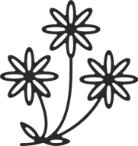

-
Why we like this plant
If your garden could use a splash of warm, earthy colour with minimal upkeep, Walther Funcke is a brilliant choice. Its coppery blooms blend beautifully with grasses and other late-summer perennials, and the soft, ferny leaves add texture and charm even when it’s not flowering. Plus, bees and butterflies love it — a win for you and for wildlife.
-
About this plant
-
Key features
- Clusters of burnt orange flowers fading to soft yellow
- Attractive to bees and butterflies
- Drought-tolerant and low maintenance
-

Eventual height and
spreadHeight: 60–75cm | Spread: 40–60cm
-

Growth
habitUpright and clump-forming with spreading feathery foliage
-

Moisture
Dry to moist but well-drained
-

Position in
the GardenIdeal for sunny borders, gravel gardens, and naturalistic schemes
Planting guide
Plant in spring or autumn in full sun. Ensure good drainage, especially in winter, and avoid overly rich soil to maintain upright growth.
Care tips
Deadhead regularly to prolong flowering. Cut back hard in late winter for fresh spring growth. Divide clumps every 3–4 years to maintain vigour.
Winter care
Leave seed heads for winter interest and wildlife, then cut back old stems in late winter or early spring.











